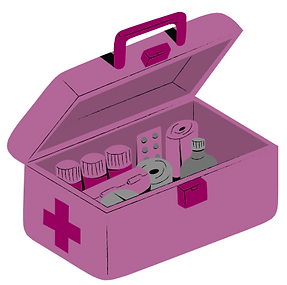Treatment
Treatment Activities
The Master Consortium created the COP-RCORP Workforce Development Workgroup to address workforce development goals related to treatment in each of the four counties. Representatives from each local consortium participated in the workgroup’s monthly meetings to discuss local challenges, identify opportunities for collaboration, and share ideas and successes. As part of the workgroup, members worked collectively and with their local consortium to create two products to address treatment workforce development needs. First, members completed a strategic plan to address a locally selected workforce development priority. Second, each county consortium examined community needs and career paths to create locally responsive career ladders.
To meet this treatment related activity, Seneca County has continued to provide support and financial resources for current partnerships with providers and explore new partnerships with stakeholders in the region and area partners to increase access to MAT providers.

As strategic plan maps and career pathways are completed and produced, the Master Consortium works with local stakeholders and state level partners to leverage resources and other supports needed to expand prevention, treatment, and recovery support staffs that can provide activities and services to complement MAT.
As a part of the training academy started because of the HRSA initiative Ashtabula County plans to continue offering the CDCA Training Academy annually and Peer Supporter training twice a year. The Training Academy is intended to increase the pool of qualified candidates and retain local providers by offering free and accessible continuing education credits. Over the course of the RCORP-I grant, 173 individuals have attended the Ashtabula CDCA Training Academy. Fairfield County plans to continue implementation of MHFA and related programs for network agencies.
Sandusky County ismaintaining a close partnership with local peer recovery support agency and continue to promote and support Ohio Mental Health and Addiction Services’ peer supporter trainings.
 Seneca County is providing support and financial resources to local providers with retention and recruitment efforts.
Seneca County is providing support and financial resources to local providers with retention and recruitment efforts.
Workforce Development Workgroup monitors and works to address recruitment and retention challenges. Career ladders provide a focus on filling gaps and enhancing existing career pathways. Recruitment and retention will remain key areas of work for the workgroup members and remains a key agenda item for each meeting.
Ashtabula County’s consortium is expanding the capacity of the local behavioral health workforce by assisting in the development of a Bachelor of Social Work Program at the Ashtabula Branch of Kent State University. A need for behavioral health workforce was identified through the HRSA Workforce Workgroup and our local consortium decided to initiate conversations with the Dean of Kent State, Ashtabula, and her staff around developing a BSW program for rural communities. Over the last 3 years, a team, which included members of the consortium, has been working to develop a curriculum and move the program through the accreditation process. The program is in place as of fall semester 2022.

Fairfield County has created a bi-weekly, ongoing support group, facilitated by a peer recovery supporter, for peer recovery supporters. The group provides peer-to-peer support to address challenges that PRS face in their unique roles.
Sandusky County continues to identify training activities to support skills development and retention in local SUD workforce.
Seneca County is working on partnership project with local provider and local university to provide loan forgiveness and scholarships. The county also supported local OUD/SUD treatment provider in receiving state grant to provide retention incentives for direct service staff members.
The Master Consortium deployed a comprehensive stigma survey in the four communities. Data from this survey are informing the selection of strategies to minimize stigma and related barriers to care. For more on the survey, Click here

Ashtabula County has been working to reduce stigma around Behavioral Health by partnering with area organizations to reduce stigmatizing language and to support anti-stigma social media campaigns that will help link people to treatment.The county plans to utilize the data received from the completed surveys to assist in stigma reduction efforts for Ashtabula County.

Fairfield County started a Maternal Opiate Medical Supports (MOMS) Project to provide outreach, case management, treatment, and recovery supports to pregnant women and new mothers with an SUD/OUD.
Sandusky County’s local consortium worked with local OB/GYN office to set up Electronic PRAF Training and referrals to Help Me Grow program. Partnered with DJFHS CSB thru the Sandusky County Maternal Health and Infant Mortality Coalition in identifying community resources for women with a SUD. The county conducted follow-up with all county OB offices to ensure they are aware of the new coding and reimbursement rates for ePRAF submissions thru Nurture Ohio.
Seneca County supported local providers with integration of telehealth and transportation services and facilitated linkages between local providers and a provider who offers psychiatric medicines through telehealth. The county also worked with local providers to expand referrals to peer recovery support services.
Ashtabula County has worked with first responders to expand Naloxone distribution through a “leave behind” program, where first responders leave a kit behind after a call for those who may need it. The County’s Quick Response Team continues to respond to non-fatal overdoses, distributes naloxone, and assists with linkage to treatment. Ashtabula County also worked with the county jail to start a Naloxone distribution to inmates upon release.
Fairfield County’s consortium developed key partnerships with law enforcement and the County Quick Response Team, Project FORT (Fairfield County Overdose Response Team). The Opiate Task Force and the FORT team work together to provide resources to the community including Narcan distribution and training. Fairfield County held a CIT Training in November 2021. This 40-hour training for Law Enforcement and Criminal Justice Workers relates to mental health and substance abuse disorder and identifying community resources to assist officers. Eleven participants completed the training. In October 2021 Project F.O.R.T. sponsored at statewide QRT conference. Fairfield County ADAMH Board and the Opiate Task Force were invited to attend the conference and speak.
Sandusky County continues adaptations to Naloxone training and distribution to ensure Naloxone is available widely in consortium service area. The consortium also strengthened collaboration and engagement with law enforcement and community first responders as law enforcement and EMS are actively involved in coalition.


Seneca County also continues adaptations to Naloxone training and distribution to ensure Naloxone is available widely in consortium service area. The consortium implemented a QRT in the service area, which brought stronger relationships with law enforcement and first responders. Free EMDR training is offered and expanded workforce can provide this service to law enforcement and first responders clinically as needed. The consortium also provided a post-traumatic stress disorder training for local law enforcement which focused on understanding PTSD with a focus on how it impacts law enforcement. Training was also offered to probation staff who also serve the SUD/OUD population. The QRT evolved into a mobile crisis response team (MCRT) increasing hours of services and responding to 911 calls.








